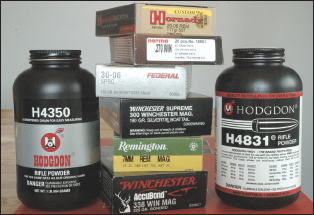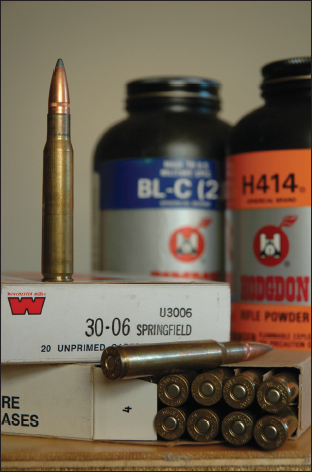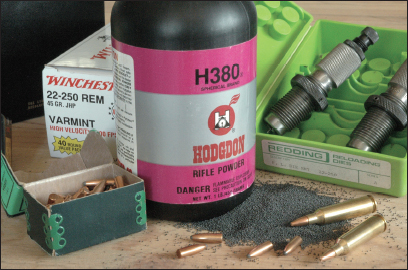11. The Hodgdon Story
After 1945, huge stocks of military powders remained in government arsenals. Bruce Hodgdon thought he could sell it to handloaders. He bought as much as he could store in underground rail cars and began parceling it out at a profit. His business grew and eventually his stocks of powder ran out. A lot of that powder was 4831. To get more powder for his customers, Bruce went to an Australian factory with a sample of the remnant. But the sample—and consequently the new 4831 that matched it—didn’t quite equal the burn rate of the original. Time in storage can affect burning characteristics. That’s why Hodgdon 4831 is a tad slower than IMR 4831. In magnum cases like the 7mm Remington and .300 Winchester, H4831 merits a charge weight increase of about 4 percent over IMR 4831 to get the same performance.
Years ago I was shown a keg of Hodgdon 4831 powder. “It’s still gray,” said its aged owner, as he unwrapped the tape holding the cardboard lid tight. He set the lid aside and plunged his hand into the silvery, slippery kernels. They dribbled through his fingers. “See. No red dust.”
I didn’t have enough .270 cases to use 50 pounds of powder, but the thought of owning that much appealed to me. I bought it. Thirty five years later, I fired a group with cartridges I’d loaded with that H4831 in the 1980s. The holes on the target touched.
Brewster E. Hodgdon was born in Joplin, Missouri, in 1910. His father and grandfather were civil engineers; he grew up as an apprentice. But one frigid day, riding in the back of an open 1917 Buick to survey a property, Bruce decided it was time to break the tradition. He studied business at Pittsburg State College, then at Washburn. He married high school sweetheart Amy Skipworth in 1934 and soon after he started work as a gas appliance salesman. Later, he and Amy bought two acres with a house and garage, a chicken coop, and a small orchard in Johnson County. That site would later serve as headquarters for Hodgdon Powder Company.

Slow powders like H4350 and H4831 excel in big cases with restrictive necks or heavy bullets.
By all accounts, Bruce was a star gas company salesman, but he wasn’t happy hewing to increasingly narrow mandates from the office. An avid shooter and reloader, he knew from his stint in the Navy during the 1940s that there was lots of powder left over from the war. Moreover, he figured there were plenty of riflemen who’d buy it from him. So he committed to 50,000 pounds, paid for with cash from a life insurance policy.
It was a gamble. Sure, this was 4895, a popular fuel for the popular .30-06. And it came really cheap. But Bruce had nowhere to store such a quantity and no market. He bought a derelict boxcar and moved it to a rented cow pasture. He placed a 1 inch ad in The American Rifleman. Mail-order price for that first Hodgdon powder was $30—for 150 pounds!
“Early on, the powder cans were metal,” says son J. B. “My brother Bob and I glued on the labels and built shipping boxes from orange crates. On our way to school, we drove tons of 4895 to REA and Merriam Frisco terminals in the trunk of a 1940 Ford.” Amy became bookkeeper. Orders soon included other reloading components and eventually rifles and ammunition. Copper-lined kegs were later replaced by cardboard. “We sold the salvaged copper for more than those first batches of powder,” recalls J. B.
By 1952, brisk powder sales prompted Bruce to quit his appliance job in Kansas City to funnel all his energy into the powder business, B. E. Hodgdon, Incorporated. J. B. and Bob joined him after finishing school in 1959 and 1961. Ted Curtis, Homer Clark, and Dave Wolfe (founder, Wolfe Publishing) helped Bruce lobby the Interstate Commerce Commission to change the classification of some smokeless powders to “Flammable Solid.” Containers under 8 pounds each, in shipments totaling less than 100 pounds, could then be delivered by common carrier. In 1966 the family separated the powder enterprise from its firearms business to form Hodgdon Powder Company. It would come to include powder magazines and packaging facilities on 160 acres six miles west of the office at 6231 Robinson in Overland Park, Kansas.

H4895 is a versatile powder in popular cartridges, here the .35 Whelen, transferred ownership to commercial interests. One of .308 and .30-06.
Bruce Hodgdon sold about four million pounds sterling of surplus powder, mostly H4831. Available in huge quantities, this slow cannon powder suited the belted magnum cartridges just beginning to snatch market share from the .30-06. “We got some surplus H4831 fresh,” J. B. recalls. “Some came from disassembled ammo. To sell it fast, we offered primers with it, in a package deal. Primers weren’t easy for handloaders to find then. One of Dad’s packages included a 150-lb keg and 15,000 primers for $49.95.” Or you could settle for a 50-lb keg with 10,000 primers, or a 20-lb keg with 5,000. “Bob and I screened that powder with a double-mesh drum cranked by hand. Big debris, such as wadding from 20mm shells, stayed in the middle. Fines sifted through to the floor. There were no SAAMI specs for performance, or practical ways to measure pressure. We tested powder uniformity with a crude electric chronograph and generated data by measuring heads of fired cases. Half a thousandth was too much expansion.”
J. B. tells me H4831 was the most uniform of the early surplus powders.
Ron Reiber has worked at Hodgdon for nearly 20 years. He knows the origins of other popular surplus powders. “H870 was fuel for the .50 BMG. We no longer offer it. H335 was first designated WC 844, a powder for the 55-grain .223 load in the M16. It followed BL-C2, developed as WC 846 for 147-grain hardball in the .308.” A powder that began as WC 852 took on a new moniker when Bruce found it gave excellent results in his .22-250. “He used 38 grains behind a 50-grain bullet for 3,800 fps,” Ron tells me. “The powder became H380.”

The .30-06 can use many powders to good effect. Two of the most useful are Hodgdon’s H414 and BL-C(2). Also: H4895.
By 1959 surplus stocks had run dry. The Hodgdons looked for commercial sources. Before and during the war, the US government had subsidized Olin and DuPont, in the US and abroad. The French-owned Australian Thales plant that currently manufactures Hodgdon’s extruded powders also got its start as a US-funded project. “After the war,” says J.B., “countries our first non-military sources was a plant in Scotland established to supply powder to the British.”
The Hodgdons bought ball powder, pioneered by John Olin in 1933, from the Olin Corp. At first Bruce called ball powders ball powders. “But we soon learned Olin had registered that name,” says J. B. “so we changed our designation to spherical.” Olin’s Winchester powder is currently made by St. Mark’s, an industry supplier owned by General Dynamics and operated at a Florida location of that name. Since 2005 Hodgdon has marketed Winchester canister powders under a licensing agreement. IMR powders are made at a factory near Montreal. DuPont chose not to sell extruded powders to Hodgdon in the 1960s. Ironically, Hodgdon now owns DuPont’s IMR business! “We also distribute Finland’s Vihtavuori line,” adds J. B. He stresses that Hodgdon is not a manufacturer. “But we do engineer powders. We developed Trail Boss with a high bulk density for Cowboy Action loads. It won’t let you double-charge a case.”
Brewster E. Hodgdon died in 1997. He lived modestly near the company he founded. A middle-class, three-bedroom home was enough. He didn’t travel much or spend a lot on himself. He gave generously to the NRA Foundation and donated land to the local Millcreek Gun Club. His interests included goose hunting and smallbore rifle competition. He taught his sons from the Bible. When he turned the company over to them in 1976, it was with no strings. It’s unlikely Bruce Hodgdon, borrowing on his life insurance for a mountain of surplus powder, could have imagined his firm marketing DuPont and Winchester lines, and cataloging 80 types of propellants. Then again, maybe that’s just what he had in mind!

As he predicted, Rich McClure liked this load of H414, 150-grain Hornadys in a .30-06 Kimber.

H380 excels in varmint cartridges like the .22-250. Hodgdon markets more than 80 propellants.
Table of contents
- Title Page
- Dedication
- Copyright
- Acknowledgments
- Foreword
- CONTENTS
- INTRODUCTION
- SECTION I: BALLISTICS IN HISTORY
- SECTION II: THE MUSCLE BEHIND THE SHOT
- SECTION III: BULLETS—THE INSIDE STORY
- SECTION IV: SPEED, ENERGY, AND ARC
- SECTION V : PUTTING BALLISTICS TO WORK
- SECTION VI: FOR LONGER REACH
- BALLISTICS TABLES FOR MODERN SPORTING RIFLES
- GLOSSARY